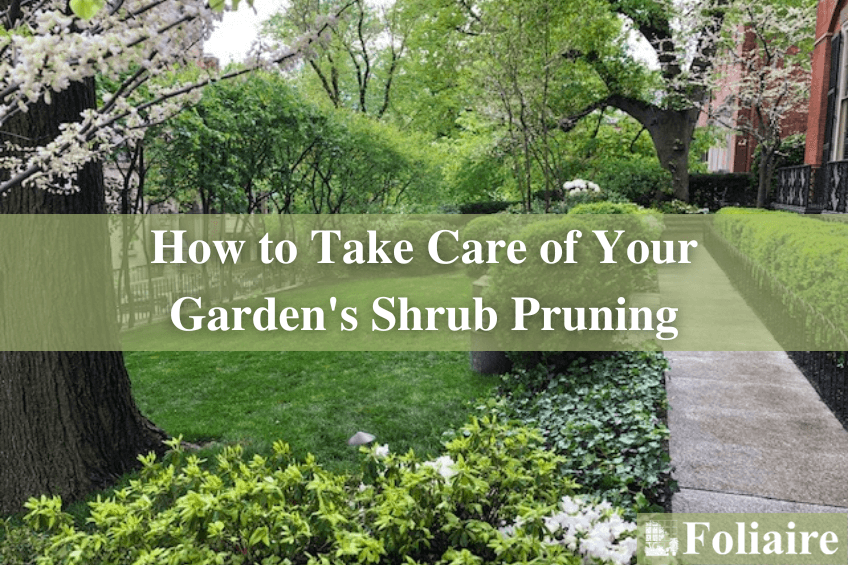How to Take Care of Your Garden’s Shrub Pruning
Shrub pruning can initially seem daunting, but once you delve into it, you’ll discover how thoroughly it can transform your garden. Mastering this essential skill is necessary if you desire abundant, healthy growth and vibrant blooms. The right gardening techniques can unlock beautifully sculpted forms in your backyard.
While different plants may have specific pruning requirements, this article provides a comprehensive overview of the fundamentals, equipping you with the knowledge and expert tips to prune your shrubs successfully.
We will cover the following:
What Is Shrub Pruning?
Pruning involves purposefully removing specific parts of a plant to achieve various objectives. It enhances the plant’s visual appeal, manages its size, promotes increased flower or leaf production, improves light penetration and air circulation, and contributes to overall plant health by eliminating dead or diseased sections.
When you remove the terminal shoot, pruning disrupts apical dominance, a term commonly used in horticulture. This process stimulates the growth of lateral buds, resulting in new shoots that contribute to a fuller and more robust plant.
How Do I Get Started Pruning My Garden?
Begin by pruning your woody plant in a specific order: dead, damaged, diseased, and structured. Removing dead, damaged, or diseased branches is crucial for the plant’s aesthetics and overall health. Next, eliminate any cross-branching or suckering branches that emerge from the plant’s base. Doing so allows the plant to channel its energy into your desired branches. Once these steps are completed, assess your plant’s needs, such as further pruning for shape, size control, flower production, or aesthetic appeal.
Different plants require various shrub pruning techniques based on their type, age, health, and size or shape concerns. However, a common plant care practice is always cutting back to just above a node. A node is a specific point on a plant stem from which one or more leaves emerge, often appearing as a slight swelling or knob. Keep reading for a brief introduction to the 4 most popular pruning methods.
Do you need help revitalizing your outdoor garden?
1) Pruning Method #1: Pinching
As the name suggests, pinching involves gently removing the terminal bud at the end of a stem using your thumb and forefinger. This action halts the upward growth of the stem, encouraging the development of bushier growth.
Pinching is typically performed on annuals, perennials, and certain small-leafed shrubs to promote compact and lush foliage.
2) Pruning Method #2: Thinning
Thinning cuts are commonly used during maintenance pruning and primarily focus on shaping the plant’s appearance. This technique entails completely removing a shoot or limb back to its point of origin on the main branch or lateral.
Implementing thinning cuts encourages new growth at the unaffected shoot tips while lateral bud development and regrowth are suppressed. Thinning cuts can help you shorten limbs, improve light penetration within the plant, reveal attractive branch structures and decorative bark, and direct the growth of shoots or limbs.
3) Pruning Method #3: Heading
Heading cuts are employed less frequently but are vital in controlling the plant’s growth pattern. This pruning method removes the terminal portion of shoots or limbs, stimulating the growth of buds located just below the cut.
Heading cuts are particularly refreshing, resulting in dense and compact growth, but they can also alter the plant’s natural form. This technique is commonly used for formally pruned hedges. Heading cuts also shape the plant, redirect growth in a desired direction, control the overall size, and increase density by promoting the growth of side stems.
4) Pruning Method #4: Shearing
Shearing is a variation of heading cuts that focus not on cutting back to a specific bud. Instead, this technique stimulates numerous buds to produce new growth, which requires regular repetition once you commence.
Since shearing involves cutting through leaves, it is best suited for small-leafed plants, as any resulting leaf damage is less noticeable. Regular shearing helps maintain a neat and compact appearance, but it should be noted that it may lead to a loss of the plant’s natural form.
Ready to upgrade your outdoor space?
Light Pruning vs. Hard Pruning
While shrubs are generally resilient and unlikely to see severe damage from incorrect pruning, it’s important to get it right first. Let’s delve into some plant care terminology and distinguish between light and hard pruning.
Light pruning involves trimming back each stem to approximately 1/4 to 1/3 of its total length, aiming for a pair of strong buds or a bud facing away from the center of the plant. This method also includes the removal of any diseased stems and ensuring an open and airy center. Sometimes, a light prune may entail cutting out up to one-third of the total number of stems. This routine maintenance should happen every 3-4 years to promote healthy growth and shape the shrub.
On the other hand, hard pruning involves more drastic measures. It requires cutting back all the stems, leaving only 2-3 buds as close to the base as possible. Additionally, up to one-third of the least healthy stems should completely fall off. After a hard prune, you should nourish the shrub through feeding and mulching to aid in rejuvenation. Hard pruning is most appropriate when a plant has become overgrown or lost its desired shape.
Which Shrub Pruning Method Is Right For Me?
Now that we’ve clarified the differences between light pruning and hard pruning, let’s outline a standard procedure to determine which method your garden needs:
- Always prune approximately 1/4″ to 1/2″ above a node, which is the point where a leaf joins a stem. Dormant buds, responsible for new stem growth, are located at nodes.
- Avoid pruning below or between two nodes, as this leaves a stub. The internode section between nodes cannot generate new stems and is prone to infection, rotting, or becoming unsightly.
- Choose nodes with buds facing away from the center of the plant, and in the direction you desire them to grow. This approach helps prevent cross-branching and encourages proper growth patterns.
- Avoid cutting a branch off flush with the trunk or stem. Instead, leave a slightly swollen area known as the collar, where a branch joins the main trunk or a larger branch. The collar contains specialized tissue that quickly seals the pruning wound and promotes healing. Always ensure the protection of the collar during pruning.
Key Takeaways
Having the right equipment can make the task more efficient regarding shrub pruning tools. A hedge trimmer with extended reach and a pivoting cutting head is ideal for trimming tall hedges. That way, you can reach those difficult areas of the plant. Look for string trimmers that accept hedge trimmer attachments to maximize functionality.
For pruning mature and overgrown shrubs, start by removing the thickest branches. Cut them back to the base of the shrub to encourage new growth and rejuvenation. Hand pruners are perfect for smaller branches, while long-handled loppers provide leverage for cutting branches 1 to 2 inches in diameter. Explore gardening or hardware stores for various hand-pruning tools and gather more information.
Remember to cut with the branch deep in the pruner’s or lopper’s jaws to exert greater cutting force. Make clean cuts to promote quicker healing for the plant. If you live in an area that experiences regular snowfall, consider shaping your hedges and shrubs with rounded tops to minimize heavy snow accumulation.
You can maintain healthy and visually appealing shrubs and hedges with the right shrub pruning tools and techniques. Happy pruning!
See how we can transform your garden today!
View Our Other Plant Care Tips
- Lawn and Garden
- Tropical Plants
- Ferns
- Philodendrons
- Fiddle Leaf Figs
- Why Are My House Plants Dying?
- How to Find the Best Garden Decor
- Top 10 Pet-Safe House Plants
- What’s the Difference Between Plantscaping and Landscaping?
Boston Fabrication Specialists
Foliaire is a full-service interior and exterior greenscape prefabrication firm in Boston’s historic South End. For over 40 years, we’ve provided award-winning urban landscaping services in the Boston Metro area.
We customize and plan our exterior landscape designs to fit your unique space and tastes. That’s how we’ve built a reputation of unparalleled style and elegance for corporate plantscaping and rooftop gardens.
In addition, we’ve received several environmental design awards and have appeared in several publications. You can find us in Architectural Digest, House and Garden, Horticulture, and Interiorscape.
Follow us on social media @Foliaire to learn more about how to improve your plantscaping:


